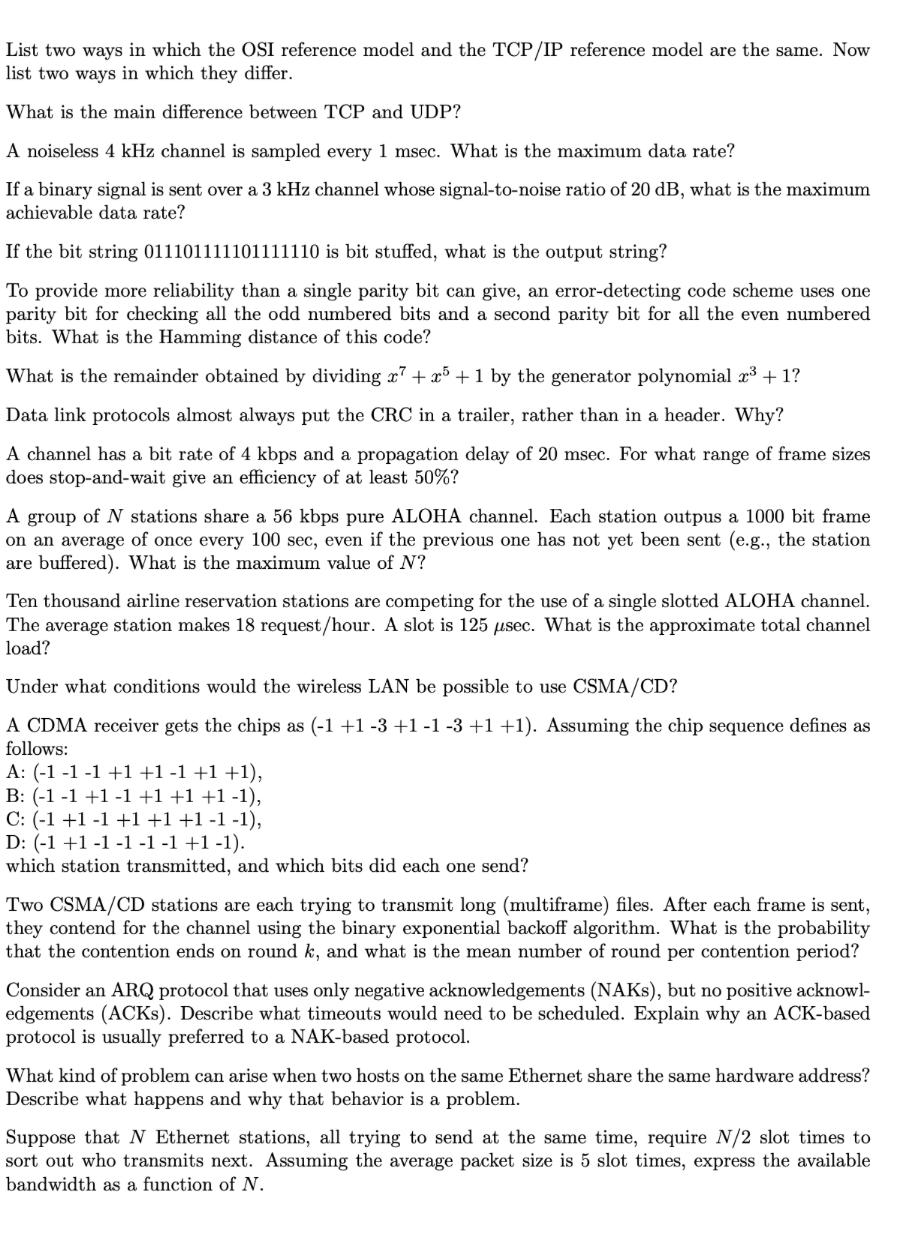Answered step by step
Verified Expert Solution
Question
1 Approved Answer
List two ways in which the OSI reference model and the TCP/IP reference model are the same. Now list two ways in which they

List two ways in which the OSI reference model and the TCP/IP reference model are the same. Now list two ways in which they differ. What is the main difference between TCP and UDP? A noiseless 4 kHz channel is sampled every 1 msec. What is the maximum data rate? If a binary signal is sent over a 3 kHz channel whose signal-to-noise ratio of 20 dB, what is the maximum achievable data rate? If the bit string 011101111101111110 is bit stuffed, what is the output string? To provide more reliability than a single parity bit can give, an error-detecting code scheme uses one parity bit for checking all the odd numbered bits and a second parity bit for all the even numbered bits. What is the Hamming distance of this code? What is the remainder obtained by dividing r7 + 25 + 1 by the generator polynomial x +1? Data link protocols almost always put the CRC in a trailer, rather than in a header. Why? A channel has a bit rate of 4 kbps and a propagation delay of 20 msec. For what range of frame sizes does stop-and-wait give an efficiency of at least 50%? A group of N stations share a 56 kbps pure ALOHA channel. Each station outpus a 1000 bit frame on an average of once every 100 sec, even if the previous one has not yet been sent (e.g., the station are buffered). What is the maximum value of N? Ten thousand airline reservation stations are competing for the use of a single slotted ALOHA channel. The average station makes 18 request/hour. A slot is 125 usec. What is the approximate total channel load? Under what conditions would the wireless LAN be possible to use CSMA/CD? A CDMA receiver gets the chips as (-1 +1 -3 +1 -1 -3 +1 +1). Assuming the chip sequence defines as follows: A: (-1 -1 -1 +1 +1 -1 +1+1), B: (-1 -1 +1 -1 +1 +1 +1 -1), C: (-1 +1 -1 +1 +1 +1 -1-1), D: (-1 +1 -1-1-1-1+1-1). which station transmitted, and which bits did each one send? Two CSMA/CD stations are each trying to transmit long (multiframe) files. After each frame is sent, they contend for the channel using the binary exponential backoff algorithm. What is the probability that the contention ends on round k, and what is the mean number of round per contention period? Consider an ARQ protocol that uses only negative acknowledgements (NAKs), but no positive acknowl- edgements (ACKs). Describe what timeouts would need to be scheduled. Explain why an ACK-based protocol is usually preferred to a NAK-based protocol. What kind of problem can arise when two hosts on the same Ethernet share the same hardware address? Describe what happens and why that behavior is a problem. Suppose that N Ethernet stations, all trying to send at the same time, require N/2 slot times to sort out who transmits next. Assuming the average packet size is 5 slot times, express the available bandwidth as a function of N.
Step by Step Solution
There are 3 Steps involved in it
Step: 1

Get Instant Access to Expert-Tailored Solutions
See step-by-step solutions with expert insights and AI powered tools for academic success
Step: 2

Step: 3

Ace Your Homework with AI
Get the answers you need in no time with our AI-driven, step-by-step assistance
Get Started


